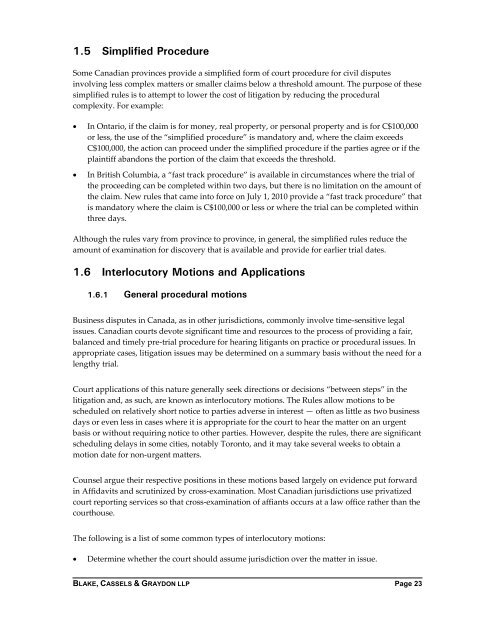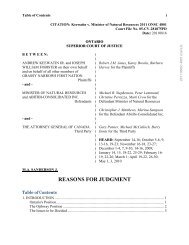Litigation and Dispute Resolution Guide
Litigation and Dispute Resolution Guide
Litigation and Dispute Resolution Guide
Create successful ePaper yourself
Turn your PDF publications into a flip-book with our unique Google optimized e-Paper software.
1.5 Simplified ProcedureSome Canadian provinces provide a simplified form of court procedure for civil disputesinvolving less complex matters or smaller claims below a threshold amount. The purpose of thesesimplified rules is to attempt to lower the cost of litigation by reducing the proceduralcomplexity. For example:• In Ontario, if the claim is for money, real property, or personal property <strong>and</strong> is for C$100,000or less, the use of the “simplified procedure” is m<strong>and</strong>atory <strong>and</strong>, where the claim exceedsC$100,000, the action can proceed under the simplified procedure if the parties agree or if theplaintiff ab<strong>and</strong>ons the portion of the claim that exceeds the threshold.• In British Columbia, a “fast track procedure” is available in circumstances where the trial ofthe proceeding can be completed within two days, but there is no limitation on the amount ofthe claim. New rules that came into force on July 1, 2010 provide a “fast track procedure” thatis m<strong>and</strong>atory where the claim is C$100,000 or less or where the trial can be completed withinthree days.Although the rules vary from province to province, in general, the simplified rules reduce theamount of examination for discovery that is available <strong>and</strong> provide for earlier trial dates.1.6 Interlocutory Motions <strong>and</strong> Applications1.6.1 General procedural motionsBusiness disputes in Canada, as in other jurisdictions, commonly involve time-sensitive legalissues. Canadian courts devote significant time <strong>and</strong> resources to the process of providing a fair,balanced <strong>and</strong> timely pre-trial procedure for hearing litigants on practice or procedural issues. Inappropriate cases, litigation issues may be determined on a summary basis without the need for alengthy trial.Court applications of this nature generally seek directions or decisions “between steps” in thelitigation <strong>and</strong>, as such, are known as interlocutory motions. The Rules allow motions to bescheduled on relatively short notice to parties adverse in interest — often as little as two businessdays or even less in cases where it is appropriate for the court to hear the matter on an urgentbasis or without requiring notice to other parties. However, despite the rules, there are significantscheduling delays in some cities, notably Toronto, <strong>and</strong> it may take several weeks to obtain amotion date for non-urgent matters.Counsel argue their respective positions in these motions based largely on evidence put forwardin Affidavits <strong>and</strong> scrutinized by cross-examination. Most Canadian jurisdictions use privatizedcourt reporting services so that cross-examination of affiants occurs at a law office rather than thecourthouse.The following is a list of some common types of interlocutory motions:• Determine whether the court should assume jurisdiction over the matter in issue.BLAKE, CASSELS & GRAYDON LLP Page 23
















